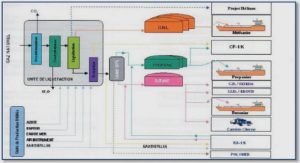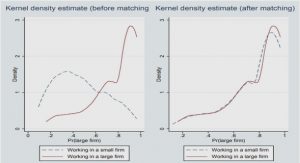Get Complete Project Material File(s) Now! »
CHAPTER TWO Evidence of olfactory communication in workers of Pachycondyla analis (Hymenoptera: Formicidae)
Abstract
Pachycondyla analis (Latreille), a widespread Ponerine ant in sub-Saharan Africa feeds solely on termites mainly belonging to the sub-family Macrotermitinae that are of economic importance in Africa. P. analis capture termites by raiding their nests or galleries. The raiding behaviour is well coordinated and organised suggesting the use of several cues including intraspecific chemical communication. To investigate the mediation of intraspecific olfactory communication in P. analis, the responses of major and minor workers to conspecific volatiles were tested in Y-tube olfactometer bioassays. Major and minor workers were responsive to their own odours and to odours of mixed groups of workers. However, major workers were significantly less responsive to odours of minor workers than to their own odours. Coupled gas chromatography-mass spectrometry analysis showed that major and minor workers shared twenty one of the forty eight identified compounds. (Z)-12-Pentacosene, n-heneicosane, n-eicosane n-tricosane, (Z)-9-tricosene and n-pentadecane were the major components in the volatiles. The amounts of volatiles released by major and minor workers on their own were two and half times higher than those released by the mixed group of ants. This study provides the first detailed account of volatiles released by P. analis and, also evidence that P. analis uses olfactory cues as part of their communication system within and outside the nest during raids on termites.
Introduction
Termites are of economic importance from two different perspectives. They assist in nutrient re-cycling (beneficial), but destroy cellulose containing materials in their quest to acquire cellulose (Culliney and Grace, 2000) causing damage to crops, forests and wooden buildings worldwide. In Africa alone they account for 15-100 % losses in crops and in tree production (Janssen, 2006). Chemical communication plays a central role in the organisation of ant societies (Hölldobler and Wilson, 1990), bringing individuals in a colony together temporarily at relevant locations by recruiting colony members and also enabling efficient interactions and utilisation of available resources within the colony. Collective exploitation and aggressive/defensive behaviours are controlled by pheromone communication systems, and these traits are presumed to be crucial in ecological dominance, most especially in introduced ant species (Holway et al., 2002).
Pachycondyla analis (Latreille) is a specialised termite predator, widely distributed in sub-Saharan Africa (Lévieux, 1966). This ant species, commonly referred to as ‘Matabele ants’, organizes group raids on termite species which mainly belong to the sub-family Macrotermitinae (Longhurst et al., 1978). These raids are initiated when a scout ant detects a potential food source (Longhurst et al., 1978, Lepage, 1981) and then recruits nestmates using trail pheromones (Longhurst et al., 1979). Upon arrival at the food source, the ants spread out, break open termite galleries and then invade them to capture the termites. P. analis workers capture termites by stinging them, after which they carry the termites out of the gallery entrance and then return to continue hunting. After gathering enough termites they stop hunting, re-group in columns and start the return journey back to their nest (Longhurst et al., 1978). A major worker and a minor worker can grasp up to seven and three termites respectively between its mandibles. Others carry no termites but lead the columns of nest mates on the return journey back to the nest (Longhurst et al., 1978). The raiding process can last between 4 and 50 min depending upon the foraging distance and the termite species being raided.
Chemical communication within and outside the nest and during raids on termites has not been described in P. analis. Previous studies reported on trail laying signals released possibly from glandular sources (Longhurst et al., 1979; Hölldobler et al., 1994; and Janssen et al., 1995).
This chapter explores the use of intraspecific chemical communication in P. analis. Responses of major and minor workers to conspecific volatiles and to volatiles from mixed group of workers were tested. The composition of the volatiles was analysed and quantified using GC-MS.
Materials and methods
Collection of ants and rearing
Colonies of P. analis with representatives of all castes (workers), males, eggs, cocoons and larva were excavated in Mpala (0°17’N, 37°52’E), a research facility of Mpala Wild Life Foundation. Mpala is located in Laikipia district, Central Kenya 250 km north of Nairobi and about 50 km from the equator and 50 km north-west of Nanyuki (Figure 1.2). The excavated colonies were transported to the Animal Rearing and Containment Unit (ARCU) located on the icipe Duduville campus Nairobi, Kenya.
Excavations were carried out either in the mornings or late in the evenings by carefully digging around the perimeter of the nest after blocking all openings to the nest to prevent ants from escaping. Ant carrying boxes which were made from plastic food containers (Figure 2.1) were partially filled with soil from the excavated nests. Ants were carefully collected and placed in the ant box using a soft paint brush and entomological forceps.
In the laboratory, ant colonies were provided with nesting boxes (20 × 20 × 20 cm) made of aluminium with a lid which could be opened to observe the nest. The base of the nesting box was partially filled with soil collected at Mpala (which served as nesting site). This was attached to a 1.0 × 1.5 m foraging arena made of Perspex also partially filled with soil which was previously washed with double-distilled water and sterilised by drying in an oven overnight (Figure 2.2).
Ants were fed on termites collected from mounds or foraging galleries around icipe Duduville campus Nairobi, Kenya. Feeding was carried out twice daily (morning and evening). Conditions in the rearing room were kept between 50 – 60% relative humidity, 24-29oC under a natural photoperiodic cycle.
Bioassays
The olfactory responses of major and minor workers of P. analis to conspecific odours were tested in a Y-tube olfactometer (Figure 2.3). The odour source consisted of (a) 20 major (b) 20 minor (c) a mixture of 10 major and 10 minor workers. The bioassays were conducted at room temperature (24 ± 1°C) and 50 – 60% RH. In order to simulate ant foraging and raiding behaviour as observed in the field, all bioassays were carried out in the mornings and evenings during the period 0700 – 1000 hrs and 1600 – 1730 hrs, respectively local time, over a number of days using ants from different colonies.
Y-tube olfactometer set-up
The olfactometer set-up (Figure 2.3) consisted of a glass Y-tube (base 7.5 cm long; Y-arms 7.5 cm long; internal tube diameter 10 mm). Each arm was extended with a small piece of Teflon tube of similar size, which was fitted to a long flexible Teflon hose that entered directly into the odour source. The base tube was also extended with a piece of Teflon tube of similar size to another flexible Teflon hose, leading to a vacuum pump. Air coming from the pump was directed outdoors to avoid contamination of the indoor air. At each end of the Y-tube a wire mesh was placed to prevent a test ant from getting out of the base or any of the Y-arms. Odour sources were placed in 200 ml glass jars (odour chambers) with screw tops containing inlets and outlets for air entering and odour to exit through the Y-tube. Each jar was connected to an air supply via flexible Teflon hoses. Charcoal-purified air was passed into the odour chambers at a flow rate of 250 ml/min. One of the Y-arms was connected to an odour source while the other was connected to an empty jar with only clean air (blank) passing through. The odours were extracted through the base arm at 500 ml/min by a vacuum pump to ensure a steady flow and to prevent odours from building up in the Y-tube. A score line was drawn on the two arms of the olfactometer at 2 cm from the joint (Figure 2.3).
Test ants were introduced individually into the apparatus by disconnecting the Y-tube at its base and allowing the ant to walk into the olfactometer. Subsequently, the tube was reconnected to re-establish airflow from the odour sources through the arms and out at the base towards the vacuum pump. An ant was allowed to settle down for 5 min, after which its behaviour was monitored. A choice was recorded when an ant chose and arm and stayed there for at least 1 min, or when it frequently visited an arm. A no-choice was recorded when the ant remained in the base arm for more than 5 min after the start of the test. Each test was terminated after 10 min from the introduction of the ant into the Y-tube. Sixty replicates were carried out for each treatment (30 minor and 30 major workers). All ants were tested against odours of their nestmates. Overall ants from three different colonies were used for the experiment. To avoid positional bias, odour chambers were rotated for every replicate. A clean Y-tube was used for each replicate in order to avoid carryover of trail following pheromones. Parts between the Y-tube, vacuum and odour sources were changed or cleaned with soapy water, rinsed with dicholoromethane and acetone after each bioassay to remove traces of trail pheromones and contaminants. All glassware were cleaned with Teepol® laboratory detergent Kent UK, rinsed with acetone and dried for five hours at 160°C in an oven. Teflon parts were rinsed with acetone and water to remove volatiles and then flushed with a stream of nitrogen to dry them.
Volatile collection and analyses
A pull-push volatile collection system (Figure 2.4) was used to collect volatiles from ants. Charcoal-purified and humidified air was continuously passed through a 2 litre volatile collection chamber (Analytical Research Systems INC, Gainesville, FL, USA) containing ~200 ants and through a filter containing Super-Q (30 mg, Analytical Research Systems INC, Gainesville, FL, USA). Volatiles released in the chamber were pulled through the filter by vacuum at 500 ml/min. Before connecting the adsorbent traps; the set-up was purged by passing humidified air through it for 20 min. This period allowed the ants to settle down in the containers. Volatiles were collected overnight for 14 hours (N = 12).
The Super-Q traps were eluted with 100µl of dichloromethane (DCM) under ice and the eluent was pushed through the trap using a gentle stream of charcoal-filtered nitrogen (N2) (Figure 2.5). To this eluent, 2 µg of ethyl nonanoate (98% purity, Sigma-Aldrich) were added as an internal standard. The volatiles were analysed on an Agilent Technologies 7890A gas chromatograph equipped with a capillary column HP-5 MS (30 m × 0.25mm ×0.25µm, ID and film thickness) and coupled to 5795C mass spectrometer.
One µl of each sample was injected in the split less mode (Inlet temperature = 250°C, Pressure = 6.83 psi), and helium was used as the carrier gas at 1.0 ml/min. The oven temperature was held at 35°C for 5 min, increased to 250°C at 10°C/min, and then held at this temperature for 15 min.
Acknowledgements
Abstract
Table of contents
General Introduction
References
Chapter 1: Termite raiding behaviour of Pachycondyla analis at Mpala, a Kenyan savannah
References
Appendix I
Chapter 2: Evidence of olfactory communication in workers of Pachycondyla analis (Hymenoptera: Formicidae)
References
Chapter 3: Nestmate recognition and the roles of cuticular hydrocarbons in the African termite raiding ant Pachycondyla analis
References
Chapter 4: Behavioural evidence of olfactory detection of prey by the termite raiding ant Pachycondyla analis (Hymenoptera: Formicidae)
References
General conclusion
References
GET THE COMPLETE PROJECT






